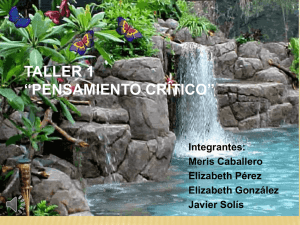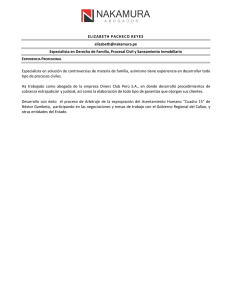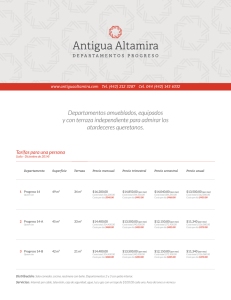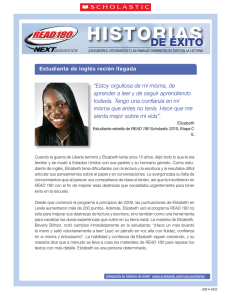elizabeth i - Junta de Andalucía
Anuncio
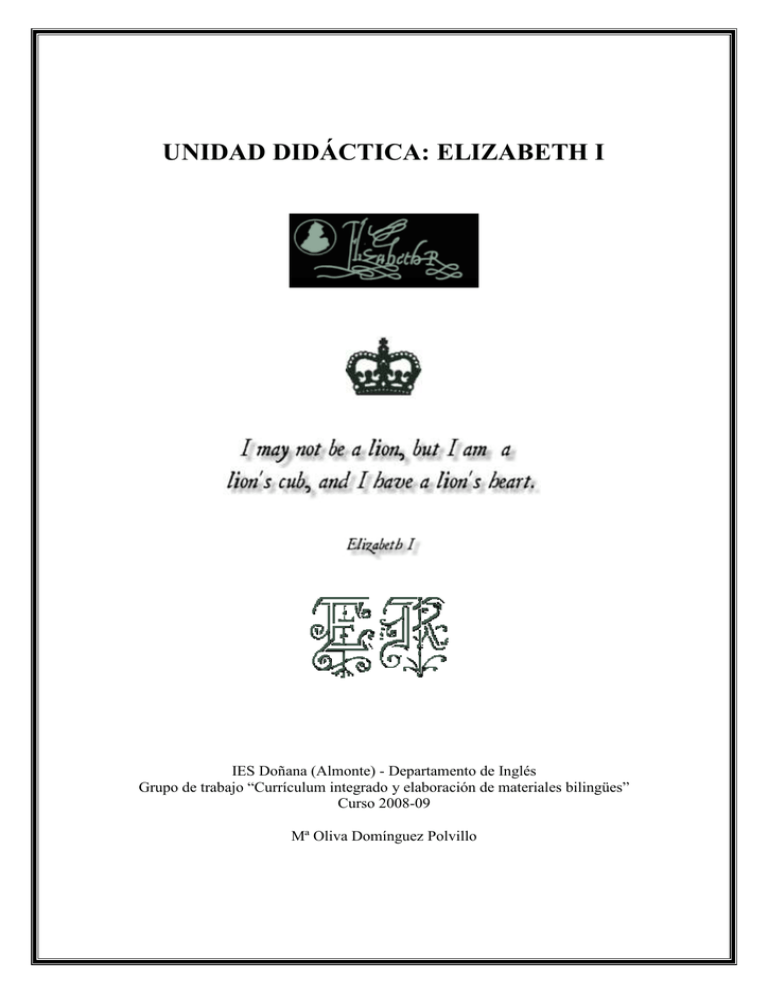
UNIDAD DIDÁCTICA: ELIZABETH I IES Doñana (Almonte) - Departamento de Inglés Grupo de trabajo “Currículum integrado y elaboración de materiales bilingües” Curso 2008-09 Mª Oliva Domínguez Polvillo ÍNDICE: - Introducción - Objetivos - Contenidos - Secuenciación de actividades - Evaluación - Metodología - Atención a la diversidad - Bibliografía - Material para el alumnado 1. INTRODUCCIÓN Esta unidad didáctica se ha diseñado para la asignatura de Historia dentro del Proyecto Bilingüe del IES Doñana de Almonte (Huelva) y está dirigida al alumnado de 2º ESO. El alumnado ya ha cursado 1º ESO bilingüe, por lo que tiene los conocimientos básicos necesarios, tanto lingüísticos como no lingüísticos, para poder seguir lo aquí programado. En cuanto a temporalización, la unidad se trabajará a finales del segundo trimestre o en el tercer trimestre del curso, por lo que se habrá realizado ya bastante práctica con textos históricos. A nivel lingüístico, se siguen las directrices establecidas en el Marco Común Europeo de Referencia y en el currículo para 2º ESO. A nivel no lingüístico, se han tenido en cuenta las directrices del currículo integrado de la Consejería de Educación en Andalucía. El centro de interés de la unidad es la época isabelina en Inglaterra (Elizabethan Age) y el enfrentamiento con la España de Felipe II. Pretendemos que el alumnado sea capaz de desarrollar la perspectiva histórica necesaria para enlazar el tema y la época con el mundo actual, pues muchas de las cuestiones aquí tratadas siguen vigentes: los cambios geográficos y el equilibrio de poder en el mundo, el papel de la mujer en la sociedad y la política, los enfrentamientos religiosos y la guerra. Se trabajarán nociones de cronología, biografía, narración, y análisis de causas y consecuencias para explicar hechos históricos, y se fomentará en el alumnado la capacidad de síntesis, el espíritu crítico y la comparación entre el presente y el pasado de España e Inglaterra. 2. OBJETIVOS OBJETIVOS NO-LINGÜÍSTICOS - Desarrollar nociones básicas de cronología. - Entender relaciones de causa-efecto y consecuencia –resultado en los hechos históricos. OBJETIVOS LINGÜÍSTICOS - Leer y comprender textos históricos diversos. - Adquirir el vocabulario específico del tema. - Redactar noticias en pasado y con conectores específicos. - Buscar y elaborar información en Inglés relacionada con el tema. 3. CONTENIDOS COMPETENCIAS BÁSICAS - Competencia en comunicación lingüística: uso del Inglés para comprender y comunicar ideas. Mª Oliva Domínguez Polvillo IES Doñana (Almonte) 2 - Competencia social y ciudadana: interacción con compañeros, trabajo en común, respeto por opiniones diversas y participación en clase. - Competencia cultural y artística: curiosidad por distintas épocas históricas. - Tratamiento de la información y competencia digital: búsqueda y elaboración de información relacionada con el tema. - Competencia para aprender a aprender: uso de estrategias de aprendizaje en Inglés. - Autonomía e iniciativa personal: capacidad para la realización de trabajos. BLOQUES DE CONTENIDOS - Bloque I (Escuchar, hablar y conversar) - Comprensión de mensajes orales: idea principal y datos específicos. - Producción de mensajes orales relacionados con el tema. - Bloque II (Leer y escribir) - Comprensión de mensajes escritos: idea principal y datos específicos. - Producción de mensajes escritos relacionados con el tema. - Bloque III (Conocimiento de la lengua y reflexión lingüística) - Vocabulario específico y contextualizado del tema: datos biográficos, hechos históricos, guerra, religión. - Pasado Simple de verbos regulares e irregulares. - Pronunciación del Pasado Simple. - Conectores: and, or, but, because, so, conectores de secuencia. - Reflexión sobre el funcionamiento de la lengua inglesa, su estructura y funcionalidad: uso del Pasado Simple. - Uso de recursos impresos e informáticos para la búsqueda de información relacionada con el tema. - Bloque IV (Aspectos socioculturales y consciencia intercultural) - Reconocimiento de la importancia de la lengua extranjera como vehículo de aprendizaje de contenidos de otras asignaturas. - Respeto por otras culturas. - Curiosidad por personajes históricos y su época. TEMAS TRANSVERSALES E INTERDISCIPLINARES - Coeducación: el papel de la mujer en el pasado y en el mundo actual. - Educación para la paz: los enfrentamientos religiosos y políticos. - Otras asignaturas relacionadas: Geografía, Religión, Educación para la Ciudadanía (en 3º ESO), Educación Plástica y Visual. 4. SECUENCIACIÓN DE ACTIVIDADES • SESIÓN 1 - WARMING UP: WHO IS WHO? Esta actividad introductoria sirve para entender la contextualización geográfica y el nexo temporal entre presente y pasado. Se puede realizar por escrito (writing) o hablando (speaking). En parejas, los alumnos/as completan la ficha con las fotografías de Felipe II, Isabel I y los monarcas actuales de Reino Unido y España. A continuación, contestan las preguntas de comprensión. En el mapa, localizan los lugares geográficos asociados a esta unidad. - BIOGRAPHIES AND TIMELINES: PHILIPH II –GOLDEN AGE AND ECONOMIC DECLINE OF SPAIN / ELIZABETH I – GOLDEN AGE OF ENGLAND Esta actividad sirve para trabajar la cronología. Los alumnos/as leen individualmente las biografías en formato esquema de Felipe II e Isabel I. A Mª Oliva Domínguez Polvillo IES Doñana (Almonte) 3 continuación, completan el ejercicio de vocabulario y contestan en pasado simple las preguntas de comprensión, que se corrigen con la participación de toda la clase. Es importante que el vocabulario quede claro pues son conceptos claves para entender éste y los siguientes textos. En parejas, completan las líneas del tiempo (cada alumno/a un monarca), donde hay que incluir necesariamente la información sobre 1588, pues este año es el núcleo de la unidad didáctica. Los alumnos/as comparan sus líneas y las personalidades de ambos monarcas, buscando diferencias y similitudes. • SESIÓN 2 - ELIZABETH’S PROBLEMS Esta actividad sirve para trabajar las causas y consecuencias de decisiones políticas en el desarrollo de hechos históricos. Los alumnos/as leen un texto sobre los problemas más importantes del reinado de Isabel I y en parejas, deciden cuales serían una prioridad para ellos, cuál sería la reacción de Felipe II y las posibles soluciones. La actividad puede servir también para reflexionar sobre el papel de la mujer en la política y sociedad de la época. Se puede realizar la misma actividad sobre el reinado de Felipe II si sobra tiempo, utilizando la información de la sesión anterior. - REASONS FOR THE ARMADA Esta actividad sirve para sintetizar la información más importante incluida en el texto “Elizabeth’s problems”. Los alumnos/as leen un texto sobre las causas del envío de la Armada a Inglaterra, completan un cuestionario y buscan la información en la sopa de letras. • SESIÓN 3 - WHY DID THE ARMADA FAIL? Esta actividad sirve para trabajar la narración de hechos históricos y explicar por qué sucedieron. Es un texto bastante complejo, por lo que habrá que poner especial atención a la comprensión. Se realiza una actividad de listening muy controlado para aprender el vocabulario. - LATEST NEWS: Esta actividad trabaja el resumen /noticia (writing) y se basa en el texto incluido en la actividad anterior. Se trata de elaborar individualmente una noticia sobre lo sucedido, siguiendo el modelo propuesto. Creemos que es interesante la narración de la derrota de la Armada desde el punto de vista español, pero se puede dar a los alumnos/as la posibilidad de escoger cualquier otro acontecimiento relacionado con la Armada que haya aparecido en las biografías de los monarcas, por ejemplo la ejecución de María de Escocia o la rebelión en los Países Bajos. Es importante que los alumnos/as utilicen los conectores adecuados para relacionar hechos. • SESIÓN 4 - INTERNET QUIZ (CUESTIONARIO INTERACTIVO) Esta actividad es opcional, pues es necesario contar con las instalaciones informáticas adecuadas. Si no se puede realizar en el centro, se puede pedir a los alumnos/as que la realicen en casa si cuentan con conexión a internet, aunque así resultará más difícil pues algunas preguntas son bastante complejas y es necesaria la ayuda constante del profesor/a. Se pueden volver a contestar las preguntas hasta que se acierta. Se puede dividir la clase en equipos y asignar un número de preguntas a cada uno de los miembros, así resulta más ameno y participan todos. Al final se Mª Oliva Domínguez Polvillo IES Doñana (Almonte) 4 pueden imprimir los cuestionarios con las respuestas acertadas, que aportan nuevos datos a los incluidos en los textos de las actividades anteriores. • SESIÓN 5 - FINAL TASK: PELÍCULA “ELIZABETH-THE GOLDEN AGE” Esta actividad también es opcional y sirve como recapitulación de lo aprendido. No se aconseja que el alumnado vea la película completa por limitaciones de tiempo y porque puede resultar difícil de entender o contener escenas inadecuadas para la edad. Además, la película presenta claramente una imagen muy favorable de la reina de Inglaterra y muy desfavorable hacia el rey de España, no es del todo objetiva. Se han seleccionado las escenas más significativas desde el punto de vista histórico y lingüístico, pues en ellas los dos personajes principales, Elizabeth y Felipe II aparecen frente a frente o se condensa en frases breves lo más básico de la historia. Lo ideal es ver una escena, parar para hacer las actividades pequeños grupos, repetir la escena y realizar una puesta en común al final. En muchos casos, es posible hacer más de una interpretación de los hechos y las respuestas pueden quedar abiertas. Para todas las actividades, se sigue el mismo procedimiento: dar copias de los subtítulos o fragmentos en Inglés a cada grupo. Pedir que los lean y anoten las ideas que les sugieran las imágenes. Explicar el vocabulario nuevo. Contestar las preguntas. Se puede utilizar la lengua materna de vez en cuando si así resulta más fácil. - MATERIAL EXTRA PARA ATENCIÓN A LA DIVERSIDAD: como deberes, se realizarán distintas fichas según las necesidades del alumnado. - CUESTIONARIO DE AUTOEVALUACIÓN: como deberes, se realiza una reflexión sobre lo aprendido, completando una tabla que recoge lo tratado en la unidad didáctica. 5. EVALUACIÓN TIPOS DE EVALUACIÓN Se realizará una evaluación continua y formativa, proporcionando feedback constante a los alumnos para orientarles durante toda la unidad didáctica. INSTRUMENTOS - Observación del grupo-clase durante la realización de actividades. - Redacción de noticia periodística. - Realización de trabajo en grupo sobre la película. - Realización de fichas de atención a la diversidad. - Realización de cuestionario de autoevaluación. CRITERIOS 5.3.1. CRITERIOS NO LINGÜÍSTICOS: - Comprender textos históricos con referencias temporales. - Comprender las relaciones entre causas y resultados en acontecimientos históricos. 5.3.2. CRITERIOS LINGÜÍSTICOS: - Entender y producir textos históricos con estructura sencilla. - Utilizar el vocabulario específico de textos históricos. - Utilizar el Pasado Simple y conectores específicos para narrar hechos históricos. - Ampliar información en Inglés sobre el tema utilizando las nuevas tecnologías. 6. METODOLOGÍA: Mª Oliva Domínguez Polvillo IES Doñana (Almonte) 5 Para esta unidad didáctica, se adopta una metodología ecléctica, práctica y comunicativa, pues la lengua inglesa se usa constantemente en clase. Además, se tienen en cuenta los siguientes principios: - Integración de las cuatro destrezas: aunque hay ejercicios específicos de listening, speaking, reading ó writing, se intenta trabajar todas las destrezas en todas las sesiones. Se ha prestado especial atención al Inglés hablado, por eso en muchos ejercicios aparece la posibilidad de iniciar un pequeño debate o intercambio de ideas (“Discuss”). - Tratamiento inductivo de la gramática: las reglas gramaticales se deducirán a través de la práctica en los ejercicios. Si los alumnos/as necesitan más práctica, se incluye una ficha de refuerzo. - Agrupaciones flexibles, con trabajo individual, por parejas ó en pequeños grupos. Se fomentará el aprendizaje cooperativo. - Tratamiento del error: se tratará el error como parte integral del proceso de aprendizaje si éste no interfiere con la comprensión. - Uso de la lengua materna: se recurrirá al español para facilitar la comprensión, sobre todo en los ejercicios de vocabulario, aunque se dará preferencia al uso de estrategias de comprensión en inglés. 7. ATENCIÓN A LA DIVERSIDAD Para atender a la diversidad de niveles, estilos y ritmos de aprendizaje dentro del aula, se pueden adaptar los agrupamientos y los tiempos dedicados a cada actividad. Se incluyen, además, dos actividades específicas para atender al alumnado con necesidades educativas especiales, una de ellas de nivel elemental ó de refuerzo (Verbos irregulares) y otra de nivel más avanzado ó de ampliación (Mujeres en el mundo actual). 8. BIBLIOGRAFÍA - Se ha utilizado material encontrado en las siguientes páginas web: www.bemorecreative.com www.casareal.es www.headlinehistory.co.uk www.historylearningsite.co.uk www.historyonthenet.com www.royal.gov.uk www.schoolhistory.co.uk www.tudorhistory.org - Película “Elizabeth, the Golden Age” 9. MATERIAL PARA EL ALUMNADO (FICHAS DE TRABAJO) Mª Oliva Domínguez Polvillo IES Doñana (Almonte) 6 WHO IS WHO? • Write the names of the kings and queens and their country under each picture: - King Philiph II of Spain - Queen Elizabeth II of the UK - King Juan Carlos I of Spain - Queen Elizabeth I of England ______________ _________________ ___________________ __________________ • Answer the following questions: - Who are the current monarchs in each country? …………………………………………………………………………………………………………………………………… - Who lived in the past and were enemies? …………………………………………………………………………………………………………………………………… - Do you know any more members of the Spanish and British royal families? …………………………………………………………………………………………………………………………………… - Do Spain and the UK have a good relationship nowadays? …………………………………………………………………………………………………………………………………… Mª Oliva Domínguez Polvillo IES Doñana (Almonte) 7 • Write the following geographical features in the map of Europe. You can colour-code the different countries: England France – Calais – The English Channel Scotland The Netherlands (Holland) Ireland Spain Why is all this information important? Wait and see! MY NAVY IS INVINCIBLE! Mª Oliva Domínguez Polvillo IES Doñana (Almonte) 8 1527: Born. His father was emperor Charles V 1556: Became king. Built El Escorial. 1557 / 1560 / 1576 / 1596: Bankruptcies in Spain. 1566: Revolt in The Netherlands (The Dutch). 1568: Revolt of the Moriscos. 1571: Defeat of Turks at Lepanto. 1576: Increase in bullion shipments to Spain from South America. 1581: Became king of Portugal. 1586: Elizabeth I helped rebels in The Netherlands. Decision to invade England. 1588: Defeat of Spanish Armada in the Battle of Gravelines. 1591: Revolt of Aragon. 1598: Died. - Apperance: Tall, dark eyes. - Personality: Loved music, art and reading. Good at history and politics. Bad at languages. Deeply religious man. Married four times: Maria Manuela of Portugal; Mary Tudor of England (Bloody Mary); Elizabeth of Valois (French); Ann of Austria. 1533: Born. Father Henry VIII, mother Ann Boleyn (executed when Elizabeth was 3 years old). Half-brother Edward became king. Half- Mª Oliva Domínguez Polvillo IES Doñana (Almonte) 9 sister Mary Tudor (Catholic) became queen when Edward died and imprisoned her at the Tower of London. 1558: Became queen at 25, after Edward’s death. Became “Supreme Governor of the Church of England”. 1559: Crowned at Westminster Abbey (London). Elizabethan Settlement to respect all religions. 1587: Throckmorton Plot by Jesuits and Spanish ambassador Mendoza against Elizabeth. Execution of Mary, Queen of Scots (Pro-French). 1588: Defeat of Spanish Armada. 1603: Died. Buried at Westminster Abbey. - Appearance: Short, red hair, black teeth. - Personality: Loved jewellery and luxury. Knew Greek, Latin, French, German and Italian. Loved horse-riding hunting and dancing. Strong temper. Superstitious. Nicknames: The Virgin Queen (never married, no children), Good Queen Bess, Gloriana. She said she was “married to the people”. • VOCABULARY: Match the words and the meanings: Bankrupcy (bancarrota) High life, expensive things Revolt (revuelta) Conspiracy Bullion (oro) False name Shipments (cargamento) Dead, put in a coffin or a grave Plot (conjura) No money Crowned (Coronado/a) Gold, coins, treasures Settlement (acuerdo) Agreement Nickname (apodo) War, conflict Luxury (lujo) Things on board a ship Buried (enterrado/a) Being the official king / queen • QUESTIONS: Answer the questions in the Past Simple tense: - What were Philiph II’s most important problems? - If Spain was a rich country, why did it continuously go bankrupt? - What important event happened when Elizabeth was only 3? - When Mary became queen, who did she marry? - Why did Mary imprison Elizabeth in the Tower? Mª Oliva Domínguez Polvillo IES Doñana (Almonte) 10 - Why didn’t Elizabeth get married? - Was Elizabeth popular in England? • TIMELINES: Complete each timeline with the most important events in the lives of Philiph II and Elizabeth I. Choose only five years. Include the year 1588 in both. Compare and discuss timelines with your classmates. THE LIFE OF PHILIPH II THE LIFE OF ELIZABETH I WHY IS THE YEAR 1588 SO IMPORTANT FOR ENGLAND AND SPAIN? • BITTER ENEMIES? Read about the king’s and queen’s appearance and personality. Can you find similarities and differences? Discuss. SIMILARITIES... DIFFERENCES... Mª Oliva Domínguez Polvillo IES Doñana (Almonte) 11 WAS IT EASY TO BE A POWERFUL WOMAN AT THAT TIME? READ ON AND FIND OUT!!! ELIZABETH’S PROBLEMS RELIGION: Philiph II was a strong Catholic. So, the 1559 Elizabethan Settlement (1) made him angry. Elizabeth wanted to stop religious problems, but the Pope (2) of Rome did not like her. MARRIAGE: Philiph married Mary Tudor (Elizabeth’s half-sister). In 1559 he offered to marry Elizabeth. She refused because she was a Protestant. A foreign husband caused more problems with other countries. PIRACY: Spain had colonies in the New World. English pirate Sir Francis Drake robbed Spanish ships. Elizabeth encouraged (3) this!. He will be the captain of the English navy against the Armada. SPANISH-AIDED (4) PLOTS: Philiph offered money or help to Elizabeth’s enemies. MARY QUEEN OF SCOTS: Elizabeth’s decision to sign (5) the death warrant (6) of Mary Queen of Scots made Philiph angry. She didn’t want to sign at first, but her ministers persuaded her. FRENCH CIVIL WAR: France was the traditional enemy of both England and Spain. Civil war broke out (7) in 1562, so France was no longer a threat (8). DUTCH REVOLT: In 1572 Elizabeth secretly helped the Dutch against the Spanish. She knew the Spanish did not have time to invade England. In 1585 she even sent an army to help the people from The Netherlands. Mª Oliva Domínguez Polvillo IES Doñana (Almonte) 12 (1)Agreement = acuerdo (2) Head of the Roman Catholic Church = Papa (3) Favour = animar (4) Helped = ayudados por (5) Put your name = firmar (6) Sentence = sentencia (7) Started = comenzó (8) Danger = amenaza, peligro ★ TOP PROBLEMS: choose three of Elizabeth’s most important problems. What was Philiph II’s reaction to them? Did he have similar or different problems in Spain? Could they find a solution to avoid war? Discuss. PROBLEM PHILIPH’S REACTION SOLUTION? Reasons for the Spanish Armada S L B P W D P W Q P I O G O E F I R U R R P J P R G R T E O F R K E Y H A U E T R T P J I J T I N E A R M A D A E O M S N Y O H K U S P A T C V O H G P R Y R A I M O H A H T Y Y N S D O I T H Y U V T D W N H V F U I C I R E L I G I O N X S A B Y B X J I P Z M K B I N Z U O P F A E B Y M Z U P P D S 1. The man who made the English ships attack the Armada was ____________________ Mª Oliva Domínguez Polvillo IES Doñana (Almonte) 13 2. 3. a. b. c. d. 4. The Spanish fleet (group of ships) was called the _______________ What were the 4 main reasons for Phillip’s attack on Elizabeth? __________________________________ __________________________________ __________________________________ __________________________________ What was the name of the religion King Philip of _____________ hated? ________________ KEY: Sir Francis Drake / Armada / Religion / Pirates / Queen Mary / Pope / Spain / Protestantism WHY DID THE ARMADA FAIL? (1) Philiph II decided to punish (2) Elizabeth’s England for a number of reasons: - Religious differences. - Rejection of his marriage proposal. (3) - English sailors or pirates robbing Spanish treasure ships. - Execution of Mary, Queen of Scots. So, he sent the Armada to invade England!. The Armada set sail (4) from Spain on 12th July 1588, with 130 ships and 30,000 men. On August 6, 1588, the Armada set anchor (5) at Calais (France). The captain was the Duke of Medina Sidonia. The English filled 80 ships with flammable materials and set fire to them (6). The English ships sailed into Spanish ships. The Spanish panicked and sailed in the open sea. The English used their artillery (7). Many Spanish galleons sunk (8). The rest sailed north, towards the coast of Scotland. They wanted to round this area and sail back to Spain. The weather was terrible, with strong winds and heavy rain so many ships were lost when they hit the rocks. The soldiers and settlers (9) of Ireland attacked them too. Only a few ships returned to Spain. Philiph II said: “I sent you to fight with men, and not the weather”. Elizabeth II said: “God blew His wind, and they were scattered” (10). Only 10,000 men returned to Spain. (1) Not win = fracasar (2) Treat badly = castigar (3) Offer = propuesta (4) Begin a journey = soltar amarras (5) Stop = fondear, parar (6) Burn = quemar (7) Weapons = armas, artilleria (8) Go to the bottom of the sea = hundirse (9) Inhabitants = habitantes, colonos (10) Lost = dispersos, perdidos. Mª Oliva Domínguez Polvillo IES Doñana (Almonte) 14 • LISTENING: listen and fill in the gaps with the words in the box: a) The Armada was made up of 130 ...........….. b) Gold, silver and precious stones are …………………………………… c) The English set the ships on ...................... d) The English strong……………………………… destroyed Spanish ships e) The bad ………………………… was the main cause of the defeat of the Spanish Armada. f) The coast of Scotland has a lot of ………………………….. rocks treasures weather ships artillery fire SO WHAT??? Mª Oliva Domínguez Polvillo IES Doñana (Almonte) 15 LATEST NEWS!!! DEFEAT OF THE SPANISH ARMADA!!! London 7 August 1588 The Spanish ships came to invade England, but yesterday 6th August, the Spanish Armada lost the battle! Philiph II, the terrible enemy of the English people, declared war because he hates our beautiful Queen. The Battle was in Gravelines, near the English Channel. At first, the English were afraid, but then, after, a big fire, the Spanish lost many ships and finally the wonderful English weather made the rest. The Scottish coast and our “friends” the Irish also helped. So, we taught the King of Spain an important lesson! God bless good Queen Bess! th • Use the information in Philiph II’s biography to write a similar piece of news for the Spanish newspaper “GOLDEN AGE SPAIN”. Don’t forget to include the following information: - What happened? - Who were there? - When did it happen? - Where did it happen? - Why? Give reasons and consequences. Use connectors: and, but, because, so, at first, then, finally. Mª Oliva Domínguez Polvillo IES Doñana (Almonte) 16 FINAL TASK: FILM ELIZABETH: THE GOLDEN AGE • SCENE 1: 1585: King Philiph II of Spain and his daughter. Voice-over / subtitles: “Spain is the most powerful empire in the world. Philiph of Spain, a devout Catholic, has plunged Europe into holy war. Only England stands against him, ruled by a Protestant Queen, Elizabeth.” Plunged = taken (conducido) / Holy war = saintly (guerra santa) / Stand against = oppose (oponerse) / Ruled = governed (gobernado /a) - Can you see any religious symbols? Give some examples. Why does the king of Spain always wear black clothes? Who is the little girl? True or False?: The little girl admires Queen Elizabeth KEY: A cross, saints, priests / He is a very serious and religious man / The king’s daughter / True: in the film, the girl is pro-Elizabeth. • SCENE 53: The attack. The Queen’s words: “And I ordered Mary’s execution. I murdered God’s anointed queen. And now God’s most dutiful son makes holy war to punish me” The King’s words blessing the Armada: “God be with you”. Anointed = chosen (elegido /a) / Dutiful = pious (piadoso, obediente) / Blessing = good wishes (bendición) - How does Elizabeth feel? How does Philiph feel? Who did the English execute? Why are they so religious? True or false? Elizabeth wanted to execute the other Queen Mª Oliva Domínguez Polvillo IES Doñana (Almonte) 17 KEY: Guilty, upset / Angry, proud / Mary Queen of Scots / Religion was very important at that time because of the Reformation / False: her ministers convinced her. • SCENE 70: The defeat Philiph II cries when he knows about the defeat of the Armada. Everyone turns their back on him, even his own daughter. She has got a doll that looks like Elizabeth. Philiph says: “This is your will, Lord”. The Queen is dressed up for one of her portraits. Turn your back = dar la espalda / Doll = toy (muñeca) / Will = desire (voluntad, deseo) / Portrait = painting (retrato). - How does Philiph feel now? - Why is the queen dressed like that? - True or False?: The Queen is very poor KEY: Sad, lonely, defeated / She used portraits as political propaganda. She wanted to show people that she was rich and powerful / False: she always wears expensive clothes. • SCENE 73: The Queen’s speech The Queen says a prayer: “I’m called the Virgin Queen Unmarried I have no master Childless I’m mother to my people God, give me the strength To bear this mighty freedom I’m your queen I’m myself” Speech = talk (discurso) / Prayer = oración / Master = boss (dueño, señor) / Strength = energy (fuerza) / Bear = put up with (soportar) / Mighty = powerful (poderoso/a). - Was it difficult for a woman to be queen at that time? Voice-over / subtitles: “The loss of the Armada was the most humiliating defeat in Spain’s naval history. Philiph died ten years later, leaving Spain bankrupt. England entered a time of peace and prosperity” (1553-1603). Loss = defeat (derrota, pérdida) - What happened in Spain and England after the defeat of the Armada? Mª Oliva Domínguez Polvillo IES Doñana (Almonte) 18 KEY: Most women married and had children. Women were not political leaders. England lived a Golden Age. Spain had a lot of problems during “El Siglo de Oro”. The defeat of the Armada marked the fall of an empire (Spain) and the rise of a new sea power (England). INTERNET QUIZ QUIZ 1: The story of the Spanish Armada. http://www.schoolhistory.co.uk/lessons/armada/armadac.htm 1. Who was the leader of Spain? Philiph II Paul II Peter II Polly II QUIZ 2: Assessment on the conflict between England and Spain. http://www.schoolhistory.co.uk/lessons/armada/conflictc.htm 1. What religion was Philiph II? Lutheran Strong Catholic Strong Protestant EXTRA ACTIVITIES Complete the following chart of IRREGULAR VERBS: find the Past Tense in the texts in this unit: BASE FORM Be Became Blow Build Come Hit Known Lose Make Send Set Sink Teach PAST SIMPLE PAST PARTIC MEANING Mª Oliva Domínguez Polvillo IES Doñana (Almonte) 19 Make a list of women who are important nowadays for political or social reasons and complete the following chart: NAME COUNTRY JOB SELF-ASSESSMENT AT THE END OF THIS UNIT, I CAN… Understand texts about Elizabeth I Understand texts about Philiph II Use the vocabulary from the unit Use the Past Simple to write about historical events Work in groups Find information in the library or on the Internet I LIKED … ☺ Mª Oliva Domínguez Polvillo IES Doñana (Almonte) 20
